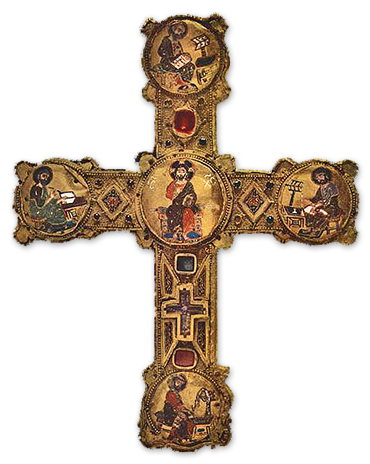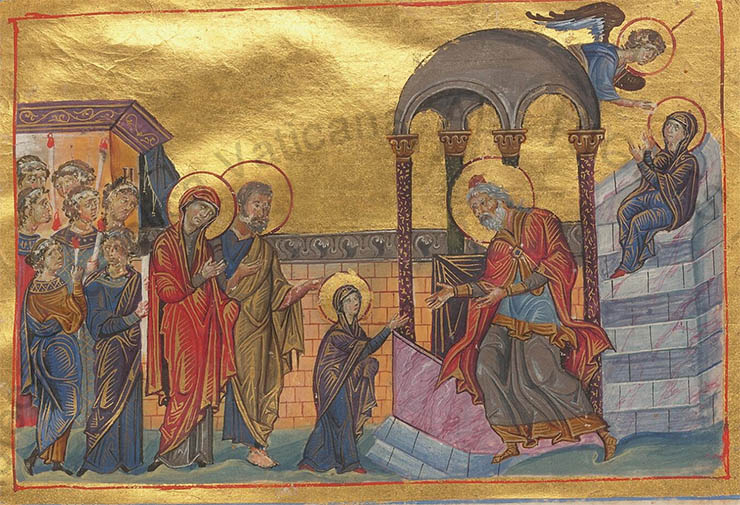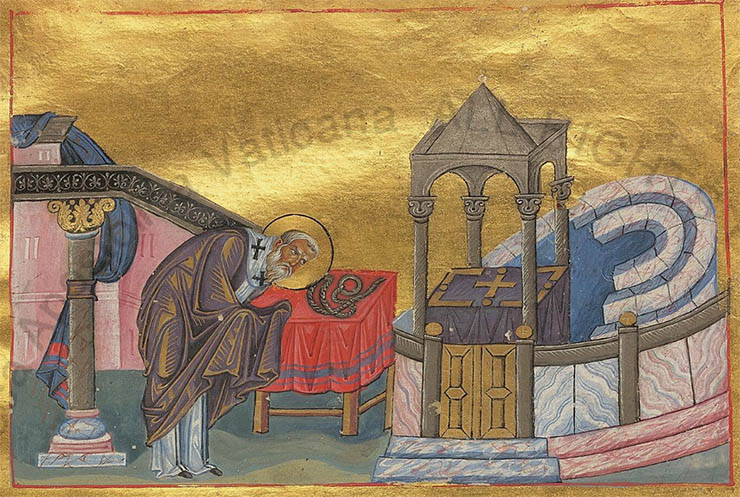




![]()



![]()


 Above a miniature of the miracle of the Archangel at Chonai painted by Pantoleon from the Menologion.
Above a miniature of the miracle of the Archangel at Chonai painted by Pantoleon from the Menologion.
The Menologion of Emperor Basil II was commissioned and executed for him and is thus dated between 976 and 1025. It is a synaxarium consisting of illustrated stories - one per page - on saints, inventions of their relics, and great feasts, for each day of the first six months of the ecclesiastical year, from September I to the end of February. The illustrations - which are signed - were executed first before the text. All the artist signatures were added by the scribe of the texts on either the right or left side of the image. Thus the labeling must have been done simultaneously with the writing of these texts. Since several of the artists had the same name, scribes had to go back and correct some of them.
In all, 8 different names accompany the 430 miniatures. In order of appearance they occur as follows with the number of their miniatures: Pantoleon - 79, Michael of Blachernae - 61, George - 45, Symeon - 32, Michael the Younger - 67, Menas - 27, Nestor - 71 and Symeon of Blachernae - 48. Pantoleon was the lead artist on the project. The illustrations were done before the book was bound.
Anna Zakarova has described the work of Panteleon as "confident, polished drawing, rich, bright colors, painstaking, smooth and gentle plastic modelling of the surfaces, natural, elegant movements of the personages, and an abundance of varied decorative effects and stylised forms." He was certainly a great master and the best European illuminator-painter of his time.
Was the Menologion painted in a central workshop where the artists came everyday to do their work? Did the artists take their work home? I wonder how long it took to paint each scene. There would have been some division of labor. The drawing would be done first, then the gilding, finally the painting of the scene took place. The last step was the addition of gold and silver highlights.
The artists did their own drawings. However, the gilding was certainly not done by the artist. The painting of each image would only have taken a day or two. I have read that the Byzantines polished the painting with a burnisher after it was done. This has caused many manuscripts to flake, however this is not true of the Vatican copy. That Menologion is is splendid condition.
There are two more versions of the Menologion; one is in Moscow and the other is in the Walters in Baltimore. It's interesting that the faces of the executioners have been erased in the Moscow copy. This copy was in a Mt. Athos monastery before it arrived in Russia. A number of Byzantine manuscripts that spent time there suffered the same fate.
The Baltimore Menologion came from the library of the Alexandrian Patriarchate in Cairo (former Cod. 33), from which it was stolen at the beginning of the 20th century; in 1930 the American collector Henry Walters bought it in Paris. It covers the month of January and has 34 images. The Moscow Menologion formerly belonged to the Kastamonitou Monastery on Mount Athos, in 1654 it was purchased on Mount Athos and brought to Moscow.
The Vatican Menologion came to Genoa in the 14th century in the hands of Bartolomeo di Jacobo and it ws in an inventory of his library in 1389. A prayer for him was inscribed in the manuscript. It went through the hands of the Duke of Milan Ludovico Sforza and others before arriving at the Vatican Library in 1615.
All of the artists lived in Constantinople and were familiar with the palaces, monuments and shrines of the city. I have selected 8 of the illustrations that have Sanctuary Ciboriums in them. 5 of them are made of silver and at least oneone illustrates the great silver ciborium of Hagia Sophia.
These images are copyrighted by the Vatican Libraries and were downloaded from their website.
 The illustration above shows the Virgin in the Temple of Jerusalem for November 21st. Mary's parents, Joachim and Anne, who had been childless, received a heavenly message that they would have a child. In thanksgiving for the gift of their daughter, they brought her, when still a child, to the Temple in Jerusalem to consecrate her to God. All of the miniatures illustrate Old and New Testament scenes in contemporary scenes of Constantinople. Above we see a ciborium with porphyry colums and a silver roof. The capitals are gilded. The Byzantines saw Hagia Sophia as the holy and sacred successor to the Temple in Jerusalem.
The illustration above shows the Virgin in the Temple of Jerusalem for November 21st. Mary's parents, Joachim and Anne, who had been childless, received a heavenly message that they would have a child. In thanksgiving for the gift of their daughter, they brought her, when still a child, to the Temple in Jerusalem to consecrate her to God. All of the miniatures illustrate Old and New Testament scenes in contemporary scenes of Constantinople. Above we see a ciborium with porphyry colums and a silver roof. The capitals are gilded. The Byzantines saw Hagia Sophia as the holy and sacred successor to the Temple in Jerusalem.
 Here we see the Annunciation to Zacharias by an angel for September 23rd; it was painted by George. The Gospel of Luke states that while Zacharias ministered at the altar of incense, an angel of the Lord appeared and announced to him that his wife would give birth to a son, whom he was to name John, and that this son would be the forerunner of the Lord. This ciborium is made of silver with gilt-silver capitals. The Royal Doors which close off the sanctuary from the nave, are gilded, without icons or decoration.
Here we see the Annunciation to Zacharias by an angel for September 23rd; it was painted by George. The Gospel of Luke states that while Zacharias ministered at the altar of incense, an angel of the Lord appeared and announced to him that his wife would give birth to a son, whom he was to name John, and that this son would be the forerunner of the Lord. This ciborium is made of silver with gilt-silver capitals. The Royal Doors which close off the sanctuary from the nave, are gilded, without icons or decoration.
 The Presentation of Jesus in the Temple, one of the 12 great feasts of the Orthodox church celebrated on February 2nd. This image was painted by Pantoleon. Notice the two turtledoves in the hands of Joseph, an offering to God. They present Jesus to Simeon. Upon receiving Christ Simeon said "Behold, this child is set for the fall and rising of many in Israel, and for a sign that is spoken against (and a sword will pierce through your own soul also), that thoughts out of many hearts may be revealed." This domed ciborium is made of silver. The slabs of sanctuary wall is made of proconessian marble. The slabs are set in a pink marble and the balustrade is made of the same stone.
The Presentation of Jesus in the Temple, one of the 12 great feasts of the Orthodox church celebrated on February 2nd. This image was painted by Pantoleon. Notice the two turtledoves in the hands of Joseph, an offering to God. They present Jesus to Simeon. Upon receiving Christ Simeon said "Behold, this child is set for the fall and rising of many in Israel, and for a sign that is spoken against (and a sword will pierce through your own soul also), that thoughts out of many hearts may be revealed." This domed ciborium is made of silver. The slabs of sanctuary wall is made of proconessian marble. The slabs are set in a pink marble and the balustrade is made of the same stone.
 The Murder of Zacharias for September 5th. This miniature was painted by Michael of the Blachernae. Orthodox Christian tradition recounts that, at the time of the massacre of the Innocents, when King Herod ordered the slaughter of all males under the age of two in an attempt to prevent the prophesied Messiah from coming to Israel, Zechariah refused to divulge the whereabouts of his son (who was in hiding), and he was therefore murdered by Herod's soldiers. This silver ciborium has a peaked roof. Jeweled curtains are hung on silver rods. The altar is covered by a stiff, gold embroidered silk cloth that is set with jewels and fringed at the bottom with more precious stones. I think this ciborium and altar depicts the one in Hagia Sophia. Alexei Lidov says "The curtain, or Catapetasma, over the main altar table of Hagia Sophia in Constantinople was not only an outstanding and unique art object of Byzantine culture, but also the most important liturgical object of the main cathedral of the Empire."
The Murder of Zacharias for September 5th. This miniature was painted by Michael of the Blachernae. Orthodox Christian tradition recounts that, at the time of the massacre of the Innocents, when King Herod ordered the slaughter of all males under the age of two in an attempt to prevent the prophesied Messiah from coming to Israel, Zechariah refused to divulge the whereabouts of his son (who was in hiding), and he was therefore murdered by Herod's soldiers. This silver ciborium has a peaked roof. Jeweled curtains are hung on silver rods. The altar is covered by a stiff, gold embroidered silk cloth that is set with jewels and fringed at the bottom with more precious stones. I think this ciborium and altar depicts the one in Hagia Sophia. Alexei Lidov says "The curtain, or Catapetasma, over the main altar table of Hagia Sophia in Constantinople was not only an outstanding and unique art object of Byzantine culture, but also the most important liturgical object of the main cathedral of the Empire."
The catapetasma was the veil that separated the Holy from the Holy of Holies in the Old Testament Temple.
 This illumination is for October 11 for the Apostle Phillip, it was painted by George. This silver ciborium has gilded capitals and bases. The altar within the ciborium has a step in marble.The roof is domed and there are carvings of leafy acanthus in the corners at the base of the dome. Curtains were often tied around these. The altar cloth is made of Imperial purple silk and hangs loose on the sides.
This illumination is for October 11 for the Apostle Phillip, it was painted by George. This silver ciborium has gilded capitals and bases. The altar within the ciborium has a step in marble.The roof is domed and there are carvings of leafy acanthus in the corners at the base of the dome. Curtains were often tied around these. The altar cloth is made of Imperial purple silk and hangs loose on the sides.
 This illustrates The Veneration of the Venerable Chain of Saint Peter. This day is January 16th. The Chain was transferred to Hagia Sophia in the 9th century where it was displayed in the Chapel of Saint Peter. This image was painted by George. This silver ciborium also has a peaked roof. Behind the altar are marble steps were clergy sat in the apse. The posts and balustrade are made of silver. Between the posts are slabs of multi-colored marble.
This illustrates The Veneration of the Venerable Chain of Saint Peter. This day is January 16th. The Chain was transferred to Hagia Sophia in the 9th century where it was displayed in the Chapel of Saint Peter. This image was painted by George. This silver ciborium also has a peaked roof. Behind the altar are marble steps were clergy sat in the apse. The posts and balustrade are made of silver. Between the posts are slabs of multi-colored marble.
Below is a image of the same illustration from the Walters Menologion, which dates from 50 years after the Vatican manuscript.

Here is the commentary on this miniature from the Walters website. The altar canopy is not marble, it is silver:
The chains that had bound the hands of St. Peter when he was imprisoned by Herod (Acts 12:6) were brought from Jerusalem to Constantinople in 438 by Eudocia, pious wife of the emperor Theodosius II. In this miniature, an anonymous bishop bows before them in an act of veneration. The relic has not actually been represented by the painter, but it supposedly lies on a table covered with red cloth and placed in front of a church altar. The altar itself is surmounted by a marble canopy and separated from the nave by a low parapet (chancel). The semi-circular benches (synthronon) behind it are seats for the high clergy. These details reflect the arrangement existing in Byzantine churches ca. 1040, when the miniature was painted.
Here is a translation of the dedication poem in the Menologion:
Do thou, O beholder, duly contemplate here the most exquisite most beautiful work of God, astounding to the mind, a work which, with reason, fills the whole Creation with joy. For above, Himself as God and Lord, who has painted the Heavens with a circling motion of stars painted the Heavens with a circling motion of stars - the Heavens, which by His Word, He stretched out like a curtain of parchment - illuminates the world through his all-wise forethought. His Word, He stretched out like a curtain the World through his all-wise forethought Below, Basil, the one how mirrors Him in character, ruler of the whole earth, Sun of the Purple, reared in purple robes, excelling in victories and learning, gladdens the minds of all of the Orthodox and cheers all contemplation with delight, having created a book truly like another Heaven, stretched out from sheets of parchment provided by Nature. This book contains beautiful images like stars; first of the Word, both God and man, then of the mother who gave immaculate birth; of wise prophets, martyrs and apostles, of all of the righteous, of angels and archangels. In ll those whom he has portrayed in colors, may he find active helpers, sustainers of the State, allies in battles, deliverers from sufferings, healers in sickness, and above all, eager mediators before the Lord at the time of Judgment, and providers of the ineffable glory and the Kingdom of God"








![]()



![]()

 click here for icons of christ
click here for icons of christ click here for icons of the theotokos
click here for icons of the theotokos click here for icons of angels
click here for icons of angels click here for icons of saints
click here for icons of saints